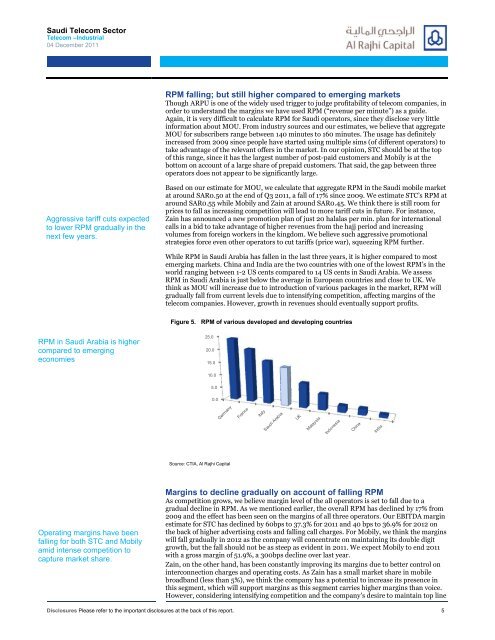Create successful ePaper yourself
Turn your PDF publications into a flip-book with our unique Google optimized e-Paper software.
<strong>Saudi</strong> Telecom <strong>Sector</strong>Telecom –Industrial04 December 2011RPM falling; but <strong>still</strong> higher compared to emerging marketsThough ARPU is one of the widely used trigger to judge profitability of telecom companies, inorder to understand the margins we have used RPM (“revenue per minute”) as a guide.Again, it is very difficult to calculate RPM for <strong>Saudi</strong> operators, since they disclose very littleinformation about MOU. From industry sources and our estimates, we believe that aggregateMOU for subscribers range between 140 minutes to 160 minutes. The usage has definitelyincreased from 2009 since people have started using multiple sims (of different operators) totake advantage of the relevant offers in the market. In our opinion, STC should be at the topof this range, since it has the largest number of post-paid customers and <strong>Mobily</strong> is at thebottom on account of a large share of prepaid customers. That said, the gap between threeoperators does not appear to be significantly large.Aggressive tariff cuts expectedto lower RPM gradually in thenext few years.Based on our estimate for MOU, we calculate that aggregate RPM in the <strong>Saudi</strong> mobile marketat around SAR0.50 at the end of Q3 2011, a fall of 17% since 2009. We estimate STC’s RPM ataround SAR0.55 while <strong>Mobily</strong> and Zain at around SAR0.45. We think there is <strong>still</strong> room forprices to fall as increasing competition will lead to more tariff cuts in future. For instance,Zain has announced a new promotion plan of just 20 halalas per min. plan for internationalcalls in a bid to take advantage of higher revenues from the hajj period and increasingvolumes from foreign workers in the kingdom. We believe such aggressive promotionalstrategies force even other operators to cut tariffs (price war), squeezing RPM further.While RPM in <strong>Saudi</strong> Arabia has fallen in the last three years, it is higher compared to mostemerging markets. China and India are the two countries with one of the lowest RPM’s in theworld ranging between 1-2 US cents compared to 14 US cents in <strong>Saudi</strong> Arabia. We assessRPM in <strong>Saudi</strong> Arabia is just below the average in European countries and close to UK. Wethink as MOU will increase due to introduction of various packages in the market, RPM willgradually fall from current levels due to intensifying competition, affecting margins of thetelecom companies. However, growth in revenues should eventually support profits.Figure 5.RPM of various developed and developing countriesRPM in <strong>Saudi</strong> Arabia is highercompared to emergingeconomies25.020.015.010.05.00.0Source: CTIA, Al Rajhi CapitalOperating margins have beenfalling for both STC and <strong>Mobily</strong>amid intense competition tocapture market share.Margins to decline gradually on account of falling RPMAs competition grows, we believe margin level of the all operators is set to fall due to agradual decline in RPM. As we mentioned earlier, the overall RPM has declined by 17% from2009 and the effect has been seen on the margins of all three operators. Our EBITDA marginestimate for STC has declined by 60bps to 37.3% for 2011 and 40 bps to 36.9% for 2012 onthe back of higher advertising costs and falling call charges. For <strong>Mobily</strong>, we think the marginswill fall gradually in 2012 as the company will concentrate on maintaining its double digitgrowth, but the fall should not be as steep as evident in 2011. We expect <strong>Mobily</strong> to end 2011with a gross margin of 51.9%, a 300bps decline over last year.Zain, on the other hand, has been constantly improving its margins due to better control oninterconnection charges and operating costs. As Zain has a small market share in mobilebroadband (less than 5%), we think the company has a potential to increase its presence inthis segment, which will support margins as this segment carries higher margins than voice.However, considering intensifying competition and the company’s desire to maintain top lineDisclosures Please refer to the important disclosures at the back of this report. 5






